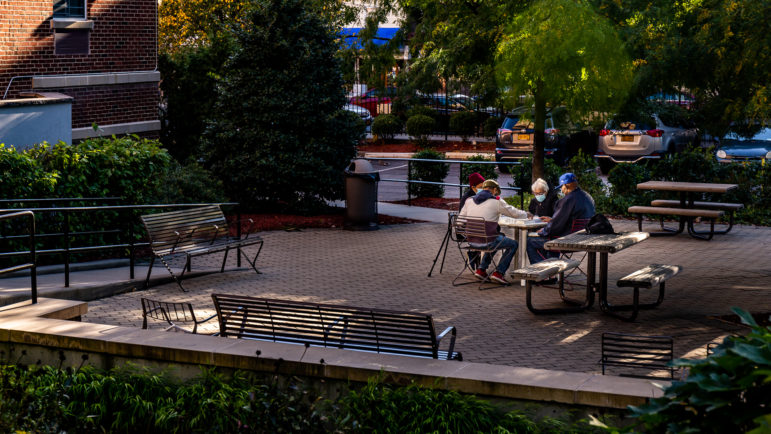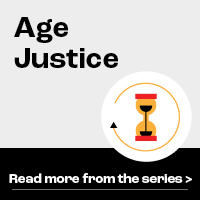The next mayor will oversee a period of profound demographic change as New York City gets grayer.

Adi Talwar
One of the tree canopied seating areas at Serviam Gardens, an affordable housing complex for seniors in the Bedford Park neighborhood of the Bronx.In 2006, the Bloomberg administration looked into the future—all the way to the distant year of 2030. Among the developments it foresaw was a sharp increase in the number of older New Yorkers: a 44 percent jump during the 21st Century, nearly three times the population increase projected for the city as a whole. The bulk of that increase, Bloomberg’s Department of City Planning foretold, would come after the year 2020.
In some ways, the future is here. The 2021 mayoral race that is now taking shape will likely determine the course of city policy through the year 2029—right up to the far edge of that first Bloomberg-era gaze into the city of tomorrow—and will elect the mayor who oversees the city’s response to the profound demographic shift underway as people not only live longer but increasingly spend their gray years in the five boroughs.
A graying city brings opportunities and challenges for residents and mayors, and these span several areas of city policy: health, public safety, housing, transit and more. To get some sense of where older New Yorkers believe the next mayor should focus, the advocacy organization LiveOn NYC recently surveyed more than 100 older New Yorkers on their hopes and concerns; some 80 people attended two listening sessions that dove deeper into the details.
Asked for the “the number one issue you would like incoming elected officials to focus on,” 37 percent answered housing stability. That’s not surprising: According to LiveOn, 65 percent of single older New Yorkers spend more than half their income on rent. Of the 165,000 affordable housing units built or preserved by the de Blasio administration through the end of fiscal year 2020 last June, only about 9,200 were specifically designated as senior units. The mayor’s handling of calls for more senior housing has long been a point of contention.
Solving the senior housing puzzle is about more than creating or preserving affordable living space, as some survey respondents indicated. As one respondent put it, “building affordable housing with services” is necessary. Another pointed out that whether they are housed already or need a city-subsidized unit, many seniors will ultimately need “homecare to avoid facilities which were so vulnerable and dangerous [during COVID].”
Second on the list of priority items for incoming elected officials—which will include not just the next mayor but also a new comptroller, four new borough presidents and the lion’s share of City Councilmembers—was “Senior Service Nonprofits,” favored by 27 percent of respondents.
“Senior Centers have been closed since last March,” one survey participant, who identified only as M. Rodriguez, wrote. “There needs to be a plan in place in the event that such a crisis happens again. … For some seniors the centers are their lifeline where they are there timely when the doors open and spend the entire day even if it is just sitting doing nothing but in need of being around other people.”
Access to health care (14 percent), food insecurity (10 percent), internet access (6 percent) and mental health supports (6 percent) rounded out the list—although many respondents simply checked off “all of the above,” reflecting the breadth of aging’s policy impact.
There were also reminders of its potential political potency. Ninety-four percent of the survey respondents said they intend to vote. That obviously indicates that a highly-engaged group took part in the survey, but national data indicates that people aged 65 to 74 boast the highest turnout rate—71 percent in 2016, compared with 44 percent for 18-to 24-year-olds. “I want to remind all elected officials that we are the largest senior population, and our voice needs to be heard,” one survey respondent wrote. “Show up for us. Don’t just listen.”
LiveOn NY notes that, despite the growing gray population, the city’s Department for the Aging still has a very small budget. “Time and time again, older adults aren’t prioritized by the city government from the lack of funding for quality aging services to the rise of social isolation among older adults as senior centers remain closed for in-person programming,” says Allison Nickerson, the executive director of LiveOn. “It’s time our city makes the aging community a true priority and not only listen to the needs of older adults but also take the necessary action to ensure older New Yorkers can truly thrive in our communities.”
Respondents were asked what the city should focus on during COVID recovery, and funding for senior services (36 percent) and senior centers (30 percent) topped the list. New Yorkers over age 75 saw the highest rate of deaths from COVID-19. Rodriguez says that part of the desire to see senior centers reopen is to give people a chance to acknowledge that loss.
“We shall be glad when the senior centers open up again and then sad knowing that many are missing as a result of this pandemic,” Rodriguez wrote. “Some of us need closure regarding our passed friends.”
In Bloomberg’s final year in office, City Planning (DCP) took another look at the numbers and foresaw an even larger 65-and-older population by 2030 than it had predicted in 2006. It also reported that growth in the older population “is projected to slow dramatically in the last decade of the projection period (2030 to 2040).” One implication of that is that, if the next mayor can set aging policy on a solid footing, the city will be well positioned to manage its new, grayer normal.
It will, however, be a very different normal from the one that New York has gotten used to, and shaped its politics and budget around. As DCP noted back in ’06, mid-20th Century New York had a share of school-age children more than twice that of the elderly. By 2030, those numbers will have basically converged, at 15.4 percent and 14.8 percent of the population, respectively. As the agency put it then, “The increasing longevity of the population, combined with a more substantial share of the city’s population that is elderly, portend a new demographic era in the city’s history.”
City Limits’ reporting on aging is supported by New York Foundation.









